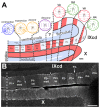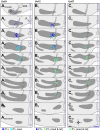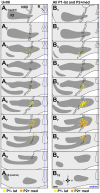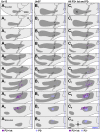Topographic Organization of Inferior Olive Projections to the Zebrin II Stripes in the Pigeon Cerebellar Uvula
- PMID: 29599710
- PMCID: PMC5862790
- DOI: 10.3389/fnana.2018.00018
Topographic Organization of Inferior Olive Projections to the Zebrin II Stripes in the Pigeon Cerebellar Uvula
Abstract
This study was aimed at mapping the organization of the projections from the inferior olive (IO) to the ventral uvula in pigeons. The uvula is part of the vestibulocerebellum (VbC), which is involved in the processing of optic flow resulting from self-motion. As in other areas of the cerebellum, the uvula is organized into sagittal zones, which is apparent with respect to afferent inputs, the projection patterns of Purkinje cell (PC) efferents, the response properties of PCs and the expression of molecular markers such as zebrin II (ZII). ZII is heterogeneously expressed such that there are sagittal stripes of PCs with high ZII expression (ZII+), alternating with sagittal stripes of PCs with little to no ZII expression (ZII-). We have previously demonstrated that a ZII+/- stripe pair in the uvula constitutes a functional unit, insofar as the complex spike activity (CSA) of all PCs within a ZII+/- stripe pair respond to the same type of optic flow stimuli. In the present study we sought to map the climbing fiber (CF) inputs from the IO to the ZII+ and ZII- stripes in the uvula. We injected fluorescent Cholera Toxin B (CTB) of different colors (red and green) into ZII+ and ZII- bands of functional stripe pair. Injections in the ZII+ and ZII- bands resulted in retrograde labeling of spatially separate, but adjacent regions in the IO. Thus, although a ZII+/- stripe pair represents a functional unit in the pigeon uvula, CF inputs to the ZII+ and ZII- stripes of a unit arise from separate regions of the IO.
Keywords: aldolase C; cerebellum; climbing fiber; inferior olive; optic flow; uvula; zebrin II.
Figures







Similar articles
-
Modulation of complex spike activity differs between zebrin-positive and -negative Purkinje cells in the pigeon cerebellum.J Neurophysiol. 2018 Jul 1;120(1):250-262. doi: 10.1152/jn.00797.2017. Epub 2018 Mar 28. J Neurophysiol. 2018. PMID: 29589816
-
Climbing fiber projections in relation to zebrin stripes in the ventral uvula in pigeons.J Comp Neurol. 2014 Nov 1;522(16):3629-43. doi: 10.1002/cne.23626. Epub 2014 May 21. J Comp Neurol. 2014. PMID: 24825798
-
Inferior olivary projection to the zebrin II stripes in lobule IXcd of the pigeon flocculus: A retrograde tracing study.J Comp Neurol. 2017 Oct 1;525(14):3158-3173. doi: 10.1002/cne.24270. Epub 2017 Jul 9. J Comp Neurol. 2017. PMID: 28649766
-
Crus I in the Rodent Cerebellum: Its Homology to Crus I and II in the Primate Cerebellum and Its Anatomical Uniqueness Among Neighboring Lobules.Cerebellum. 2018 Feb;17(1):49-55. doi: 10.1007/s12311-017-0911-4. Cerebellum. 2018. PMID: 29282617 Review.
-
Compartmentalization of the deep cerebellar nuclei based on afferent projections and aldolase C expression.Cerebellum. 2011 Sep;10(3):449-63. doi: 10.1007/s12311-010-0226-1. Cerebellum. 2011. PMID: 20981512 Review.
Cited by
-
Cerebellar Modules and Their Role as Operational Cerebellar Processing Units: A Consensus paper [corrected].Cerebellum. 2018 Oct;17(5):654-682. doi: 10.1007/s12311-018-0952-3. Cerebellum. 2018. PMID: 29876802 Free PMC article. Review.
-
From the eye to the wing: neural circuits for transforming optic flow into motor output in avian flight.J Comp Physiol A Neuroethol Sens Neural Behav Physiol. 2023 Sep;209(5):839-854. doi: 10.1007/s00359-023-01663-5. Epub 2023 Aug 5. J Comp Physiol A Neuroethol Sens Neural Behav Physiol. 2023. PMID: 37542566 Review.
-
Proprioceptive engagement of the human cerebellum studied with 7T-fMRI.Imaging Neurosci (Camb). 2024 Aug 14;2:imag-2-00268. doi: 10.1162/imag_a_00268. eCollection 2024. Imaging Neurosci (Camb). 2024. PMID: 40800446 Free PMC article.
-
Structural and Functional Organization of Visual Responses in the Inferior Olive of Larval Zebrafish.J Neurosci. 2024 Feb 21;44(8):e2352212023. doi: 10.1523/JNEUROSCI.2352-21.2023. J Neurosci. 2024. PMID: 38195508 Free PMC article.
-
Cerebellar Inputs in the American Alligator (Alligator mississippiensis).Brain Behav Evol. 2023;98(1):44-60. doi: 10.1159/000527348. Epub 2022 Dec 1. Brain Behav Evol. 2023. PMID: 36455518 Free PMC article.
References
-
- Ahn A. H., Dziennis S., Hawkes R., Herrup K. (1994). The cloning of zebrin II reveals its identity with aldolase C. Development 120, 2081–2090. - PubMed
-
- Arends J. J. A., Voogd J. (1989). Topographic aspects of the olivocerebellar system in the pigeon. Exp. Brain Res. Suppl. 17, 52–57. 10.1007/978-3-642-73920-0_6 - DOI
LinkOut - more resources
Full Text Sources
Other Literature Sources
Research Materials

